Categories: Electrician at home, Electrical connection of equipment
Number of views: 30701
Comments on the article: 1
Connection diagrams of voltage relays in single-phase and three-phase networks
In all power grids, voltage surges periodically occur that can damage electrical equipment. Network surges for electronics are especially dangerous. To protect themselves from them, people use stabilizers and voltage relays. Let's look at what is and how to connect a voltage relay.
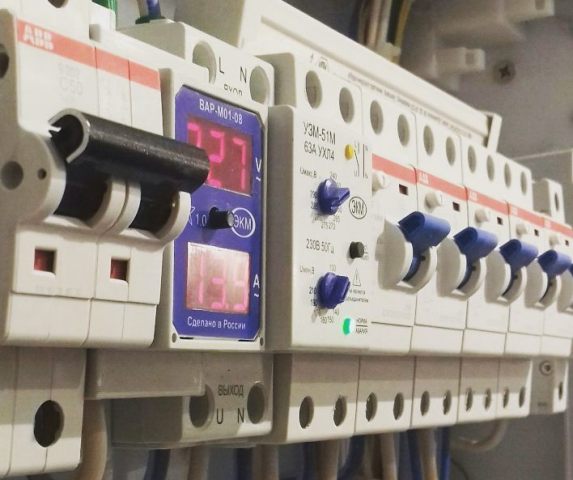
What is it, what are they, and other frequently asked questions about voltage relays
Voltage relay - a device that disconnects the supply network from the load with abnormal voltage values in it. On modern common voltage relays there is a display or a group of seven-segment LED indicators and several buttons for setting the operating mode.
The display or indicators usually show voltage. Less often, there are two of them, and the second displays the current. You can configure the extreme voltage values (upper and lower limits) at which you need to turn off the power to consumers. Depending on the model, LEDs can be installed to indicate network status, operation mode and current position in the setup menu.
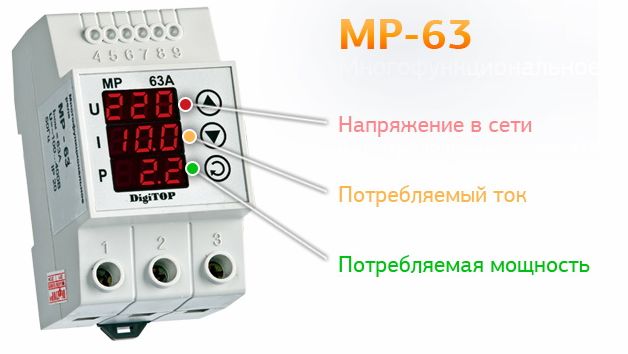
You can also set the reclosing time. The relay will turn on after a specified period of time and if the voltage in the network has reached the rated voltage, it will continue to work; if not, it will turn off.
By type of construction can be for mounting on a DIN rail or those that are inserted into the socket, the same organs and socket for connecting the protected load are located on their case. Such relays are convenient to use to protect a particular device or group of devices.
In addition, the voltage monitoring relay can be in other versions, for example, built into an extension cord. Socket voltage relays are the cheapest - their cost starts from 500 r.
What are power surges and why?
Power surges occur due to switching of powerful devices (on and off), due to problems on power lines and substation equipment. Increased or reduced voltage can be either a pulse or short-term (jump), or long.
Long-term voltage deviations most often occur during phase imbalance, this is the state of a three-phase power network when it works without a neutral conductor and its phases are unevenly loaded. This happens when on the access panel of an apartment building the neutral conductor burns out. Then in some apartments the voltage jumps to 300 volts, and in others it drops below 200. This is an extremely dangerous mode of operation for any type of household appliances and wiring.
How is a voltage relay different from a stabilizer and which is better?
The voltage stabilizer is arranged so that the control system strives to maintain the set voltage or close to it (for example, 220V) at its output, with fluctuations in the input voltage in a certain range.
There are various types:
-
Relay - inexpensive, regulate the output voltage stepwise.
-
Electromechanical - smoothly adjust the output voltage, like an autotransformer.
-
Electronic, on simistor or thyristor or other semiconductor switches, complex and expensive devices.
-
Invertor.
-
Ferroresonance - were especially common in Soviet times, for example, the stabilizer "Ukraine". In most cases, ineffective.
The reaction time of such stabilizers, depending on their design, reaches a second. During this time, your equipment may already fail, while the response time of the voltage relay is measured in fractions of a second.
It is best to use them in pairs, and if taken separately, then you can’t specifically say which is better.In terms of protection against overloads - a voltage relay, and in terms of continuous operation, of course, stabilizer.
How to connect a voltage relay?
The voltage relay is connected to the power supply gap, between the meter and a group of machines, or an input machine. If there is no group of machines, which is most often the case in old apartments, then you can mount it after the machine that powers the apartment.
Here is the simplest voltage relay connection diagram:
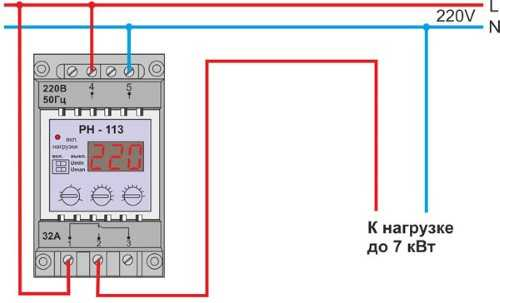
Depending on the specific instance of the relay, the pin assignment (terminals) may vary, but the basic principle is as follows:
Two wires come to the relay (phase and zero), and one leaves - phase, zero in the relay does not open, only the phase opens. On the model shown in the picture, a different arrangement of terminals.
Here, two supply wires are connected to the input of the relay measuring circuit, when it detects a voltage deviation in excess of the set voltage, it switches the relay itself. In this case, in your location there are two pairs of contacts (normally-closed and normally-open), this is indicated in the schematic designation on the bottom of the relay.
This is necessary to implement various schemes, for example, generating a signal to start a generator or other uninterrupted power supply system in your home, or turning on emergency lighting and turning off important circuits.
The following is a diagram of the relay connection in pair with RCD or difavtomatom, they are needed to prevent electric shock to the residents of your apartment, from the housings of electrical appliances and other parts. In principle, the same as in the previous figure.
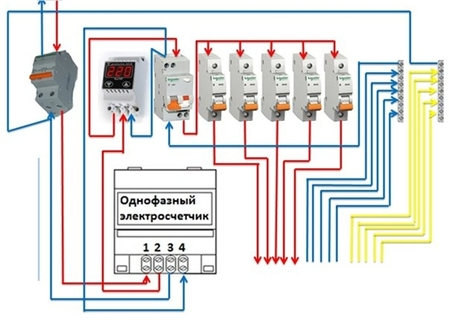
Scheme for individually setting the voltage permissible for each circuit. This is convenient if you have correctly made wiring, and the outlet groups of each room are powered by different machines, as well as lighting circuits and powerful consumers. Then you can use an arbitrary number of voltage monitoring relays and set permissible limits for each consumer.
In practice, this is necessary in order to protect expensive equipment, such as a refrigerator and a washing machine, from fluctuating in the power supply network, but at the same time the light will remain on.
If you want to unload the relay contacts so that it lasts longer or the power of your instance is not enough to power your consumers, put between the relays starter (contactor) or more powerful relaythen the relay output terminal must be connected to the coil of your switching device. So, when the voltage goes beyond the permissible limits, the contactor coil is de-energized, its contacts open and consumers are disconnected from the network.
Such a circuit can also be used in a three-phase power supply network. If the voltage deviates in one of the phases, a three-phase magnetic starter or contactor will disconnect the load, thus protecting it.
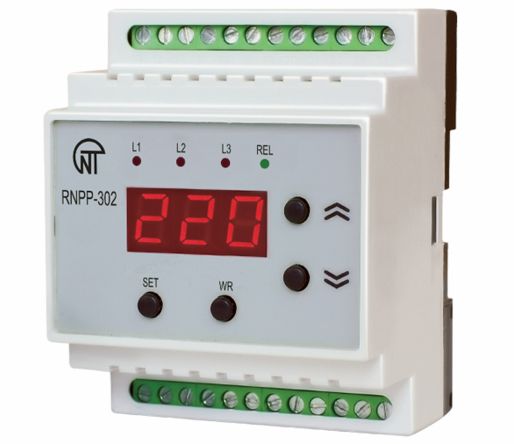
For three-phase circuits, three-phase voltage and phase imbalance relays are generally sold, and also, a phase monitoring function is built into them (depending on the model). Details about him are described in this video:
In general, it is undesirable to use three single-phase voltage monitoring relays in a three-phase network, I believe that this can lead to damage to electrical equipment, since for some three-phase consumers.
There are models and simpler, the switching circuit resembles a circuit with a single-phase relay.
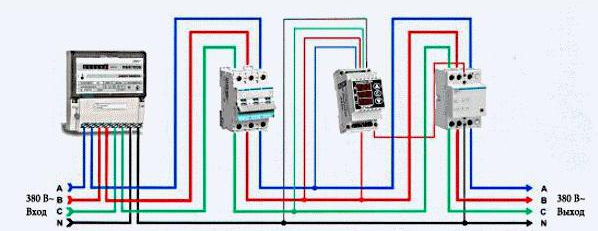
Here, a three-phase relay monitors the voltages of each phase, and in the event of an emergency in the network, it turns off the coil of the three-phase starter or contactor.
Conclusion
Voltage monitoring relays are a cheap way to secure wiring and household appliances in your apartment. It can be bought for 1-2 thousand rubles, there are models worth and more expensive. To install it does not require much space, which can not be said about installing a powerful stabilizer. It does not make sounds during its operation (electromechanical and relay stabilizers make), they click only during switching.
I believe that a voltage relay should be installed, at least to power especially important and expensive consumers, if there is no way to install a relay on the whole apartment, buy outlet models. The simplest options do not have settings, but only turn off the network when reaching the settings configured at the design stage.
See also at bgv.electricianexp.com
:
